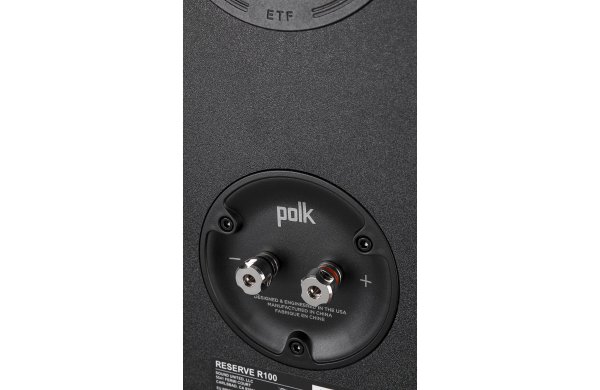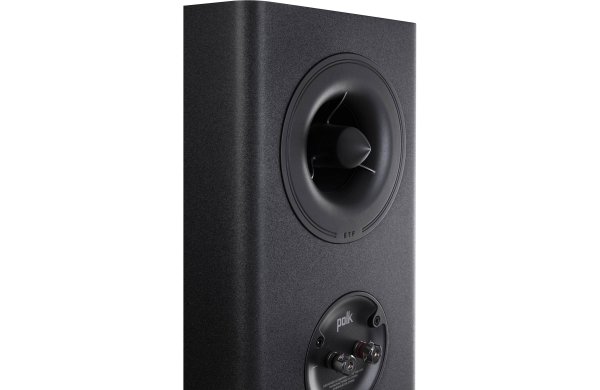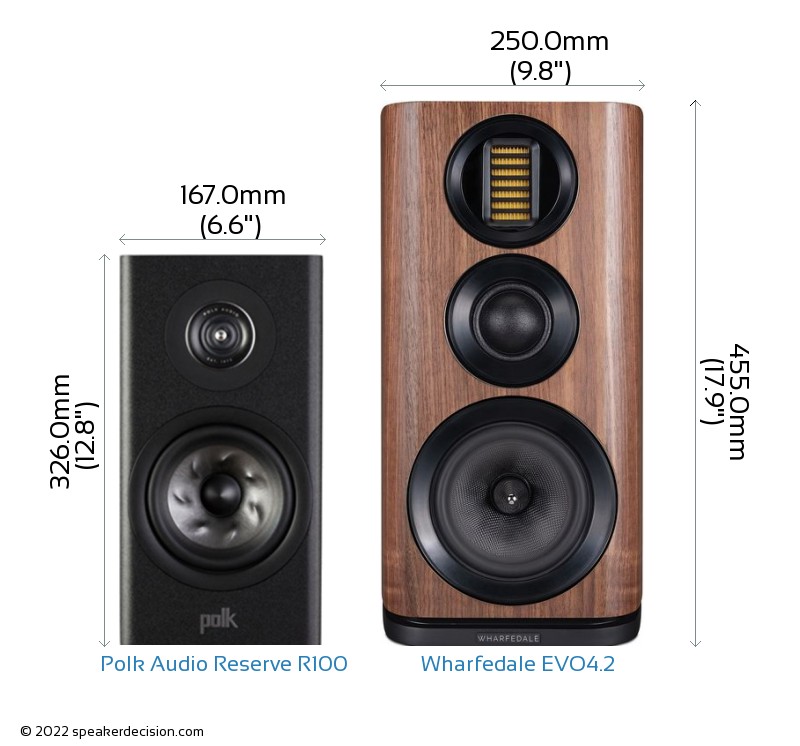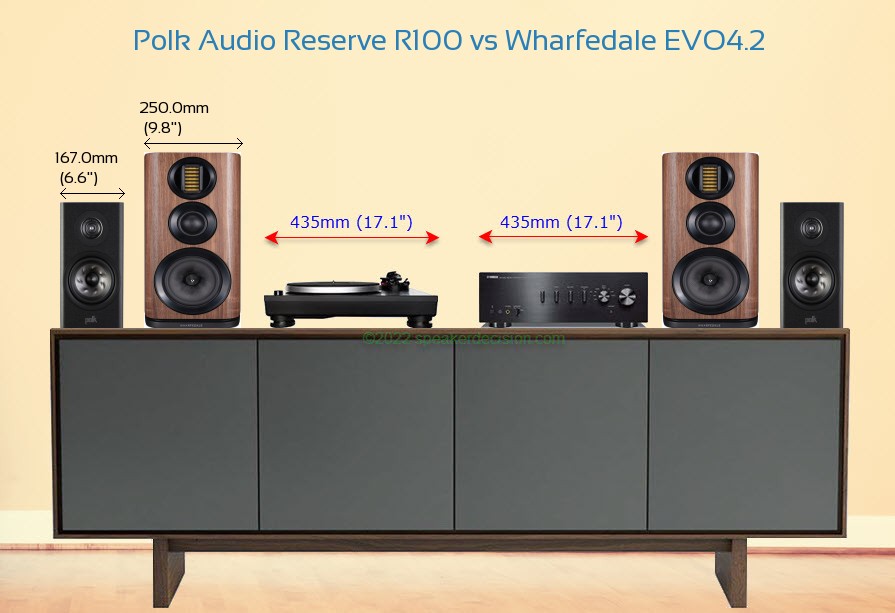In this review, we will be comparing R100 and EVO4.2, two Passive Bookshelf speakers from Polk Audio and Wharfedale. Let's have a brief look at the main features
of Polk R100 and Wharfedale EVO4.2 first before getting into our more
detailed comparison.
What size room are the Polk R100 and Wharfedale EVO4.2 speakers good for?
The size of the room in which you are planning to use these loudspeakers is an important decision factor. Here we have compared their suitability to various sizes of environments considering their size and max power parameters:
In the following sections, we will get into more detail in order to better understand how the Polk R100 and Wharfedale EVO4.2 compare and hopefully end up with enough arguments to decide which one of these loudspeakers is the better choice for you.
**This post contains affiliate links, and I will be compensated if you make a purchase after clicking
through my links. As an Amazon Associate I earn from qualifying purchases.
Drivers
One of the fundamental differences between these two speakers is that R100 is a 2-way design whereas the EVO4.2 is a 3-way speaker. 3-way designs utilize a midrange driver in addition to the tweeter and woofer on 2-way designs. Designing a crossover for a 3-way speaker is a complicated process and generally increases the overall cost of the speaker.
| Driver |
Polk R100 |
Wharfedale EVO4.2 |
|
Driver Setup
|
2-way
|
3-way
|
|
Tweeter
|
1-inch
|
1.18x2.36-inch
|
|
Midrange
|
- |
1 x 2-inch |
|
Woofer
|
1 x 5.25-inch
|
1 x 6.5-inch
|
R100 features a 1" Pinnacle Ring Radiator Tweeter and 1 x 5.25" Polypropylene Turbine Cone Woofer with a Crossover frequency at 2700Hz. On the other hand, the EVO4.2 features a 1.18x2.36" AMT (Ribbon) Tweeter , a 2" Midrange and 1 x 6.5" Kevlar Woofer .
Frequency Response
R100 has a frequency range of 58-39k Hz whereas EVO4.2 has a frequency range of 54-22k Hz. With a minimum frequency of 54Hz, the EVO4.2 can go slightly deeper then the R100's min frequency of 58Hz.
Below graphs depict how these two speakers compare with the max, min and average values of the Min and Max Frequencies of other speakers in the Bookshelf class in our database.
Low Frequency
Bookshelf Speakers
High Frequency
Bookshelf Speakers
None of these speakers achieves full range experience which is commonly agreed as 20Hz-20kHz. In order to achieve lower lows / deeper bass, we recommend you pair these with a subwoofer. Visit our Powered Subwoofers section to find out more about the available options.
Impedance and Sensitivity
R100 and EVO4.2 have the same Impedance of 8 ohms but where they differ is the sensitivity levels. R100 sensitivity is rated at 86 dB and the EVO4.2's is at 88 dB. This 2 dB difference makes the Wharfedale EVO4.2 a more sensitive speaker compared to Polk R100, hence will play louder with the same amount of watts.
Sensitivity
Bookshelf Speakers
Power Range
Power
range is the range of input power in watts RMS that a loudspeaker is designed to handle. While using an amplifier within this range ensures the nominal performance , inputting a power that is higher than the max wattage can result in a damaged speaker.
R100 can handle a max power of 150 watts RMS from the amp the whereas EVO4.2 has a max power handling value of 120 watts RMS, 30 watts less than the R100.
Keep in mind that a higher max power handling value doesn't necessarily make that a louder speaker
compared to a lower max handling speaker. Loudness or the sound level is also impacted by parameters
such as Impedance, sensitivity and system efficiencies.
Input Type and Bi-Amping / Bi-Wiring
EVO4.2 features Post posts which make bi-amping or bi-wiring possible. R100 has a Binding post which doesn't feature bi-amping/bi-wiring.
 Polk R100's Binding post terminals
Polk R100's Binding post terminals
Cabinet Type and Port Position
R100 has a rear firing port whereas EVO4.2 has a bottom firing ports. Wharfedale EVO4.2's bottom-firing port gives more flexibility in placement in regards to proximity to walls compared to Polk R100 with its rear-firing port.
 Polk R100 Port
Polk R100 Port
Physical Specs
Size of a speaker can sometimes become an important decision factor due to space constraints or in some cases purely for esthetic reasons. In this section, we are going to compare Polk R100's and Wharfedale EVO4.2's external dimensions. Polk R100 has external dimensions of 326.0 x 167.0 x 259.0mm ( 12-13/16 x 6-9/16 x 10-3/16inch) whereas Wharfedale EVO4.2 has external dimensions of 455.0 x 250.0 x 350.0mm ( 17.9 x 9.8 x 13.7inch) .
Wharfedale EVO4.2 is clearly the larger of the two speakers. Its body is 83mm wider, 129mm taller and 91mm deeper than Polk R100.
Below you can see the front view size comparison of Polk R100 and Wharfedale EVO4.2 in scale.
 Comparison image of Polk R100 and Wharfedale EVO4.2 Size and External Dimensions
Comparison image of Polk R100 and Wharfedale EVO4.2 Size and External Dimensions
Base Surface Area Comparison
Base surface area of a loudspeaker may become a determining factor when the space in your room or desk is limited.
The base surface area of the Polk R100 is approximately 432.5cm2 / 67.0inch2 and base area of the Wharfedale EVO4.2 is approximately 875.0cm2 / 135.6inch2. The R100 requires 51% less surface area than the EVO4.2 which gives it a small advantage on placement in tight spaces.
Here is an another comparison that shows both speakers on a BDI Octave Media Cabinet, next to a standard size amplifier and turntable in scale:
 Size Comparison image of Polk R100 and Wharfedale EVO4.2 on a Media Console
Size Comparison image of Polk R100 and Wharfedale EVO4.2 on a Media Console
Weight Comparison The weight of a loudspeaker can become an important factor if you need to move and reposition the unit often. Weight of a speaker can also "sometimes" be an indicator of the rigidity of the enclosure and the quality of the internal components used. The Polk R100 weighs 5.55kg / 12.2lbs and the Wharfedale EVO4.2 weighs 13.40kg / 29.5lbs. This makes the EVO4.2 141% heavier than the R100.
Here is a comparison of how R100 and EVO4.2's weights compare with the average, max and min weights in Passive Bookshelf class.
Weight
All Bookshelf Speakers
What's in the Box of Polk R100?
Here are the items that are included inside the box of R100:
2 Bookshelf loudspeakers2 GrillesOwners ManualOnline Registration
What's in the Box of Wharfedale EVO4.2?
Here are the items that come with the EVO4.2:
2 Bookshelf loudspeakers 2 Grilles 4 Jumper-bars (pre-installed) 8 Self-adhesive rubber feet Pair of white cloth gloves User Manual
 Max Input Power Max Input Power |
150 watts
vs
120 watts
|
Handle more power from your amplifier |
 High Frequency Response High Frequency Response |
39k Hz
vs
22k Hz
|
Generates higher frequency |
 Height Height |
326mm
vs
455mm
|
Easier to fit in smaller spaces |
 Base Surface Area Base Surface Area |
432cm2 (167x259mm)
vs
875cm2 (250x350mm)
|
Takes less floor space |
 Price per pair* Price per pair* |
649USD
vs
1199USD
|
costs less (*prices may change depending on the seller, location and time) |
 Driver Setup Driver Setup |
3-way
vs
2-way
|
Have a dedicated mid-range driver |
 Sensitivity Sensitivity |
88 dB
vs
86 dB
|
Play louder with same amount of amplification power |
 Minimum Impedance Minimum Impedance |
4 ohms
vs
3.6 ohms
|
Very low impedance levels puts more pressure on amplifier |
 Woofer Size Woofer Size |
6.5 inches
vs
5.25 inches
|
Larger woofer |
 Low Frequency Response Low Frequency Response |
54 Hz
vs
58 Hz
|
Generates deeper bass |
 Bi-Amping and Bi-Wiring Bi-Amping and Bi-Wiring |
Yes
vs
No
|
Allows bi-amping and bi-wiring connections |
| General |
Polk Audio Reserve R100 |
Wharfedale EVO4.2 |
| Brand |
Polk Audio |
Wharfedale |
| Speaker Type |
Bookshelf speakers |
Bookshelf speakers |
| Power Range |
30-150 watts |
25-120 watts |
| Sensitivity |
86 dB |
88 dB |
| Impedance |
8 ohms |
8 ohms |
| Impedance |
3.6 ohms |
4 ohms |
| Frequency Response |
58-39k Hz |
54-22k Hz |
Drivers |
|
|
| Woofer Quantity |
1 |
1 |
| Woofer Size |
5.25" |
6.5" |
| Woofer Composition |
Polypropylene Turbine Cone |
Kevlar |
| Woofer Surround Material |
Rubber |
Rubber |
| Tweeter Size |
1" |
1.18x2.36" |
| Tweeter Type |
Pinnacle Ring Radiator |
AMT (Ribbon) |
| Aimable Tweeter |
No |
No |
| Midrange Driver |
No |
2" |
| Crossover Frequency |
2700Hz |
n/a |
| Firing Direction |
rear |
bottom |
Physical Specs |
|
|
| Height |
326.0mm (12.8") |
455.0mm (17.9") |
| Width |
167.0mm (6.6") |
250.0mm (9.8") |
| Depth |
259.0mm (10.2") |
350.0mm (13.8") |
| Weight |
5.55kg (12.2lbs) |
13.40kg (29.5lbs) |
| Enclosure |
Bass Reflex |
Bass Reflex |
| Finish |
MDF/Vinyl |
MDF/Wood-veneer |
| Available Colors |
Black, Walnut, White |
Walnut,Black,White |
| Mounting Bracket |
No |
No |
| Recommended Stand Height |
24-28" |
18-22" |
| Grille |
Yes |
Yes |
| Moisture Resistancy |
No |
No |
Connections |
|
|
| Biamp Inputs |
No |
Yes |
Other |
|
|
| Parts Warranty |
5 Years |
5 Years |
| Labor Warranty |
5 Years |
5 Years |